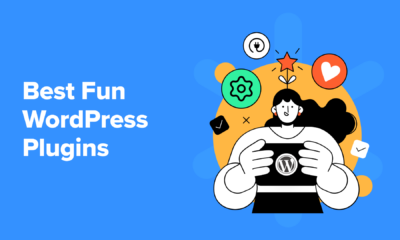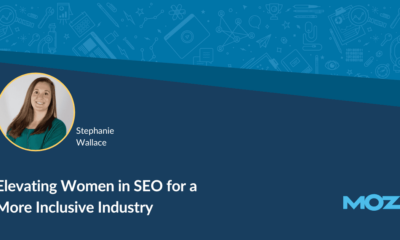MARKETING
Fix Outdated Content To Boost Your SEO Results
If your organization has been around for more than a year or two, your website probably holds a mountain of published content. Much of that content no longer helps your audience or your brand because it’s outdated or irrelevant.
But it doesn’t hurt anything, right?
Wrong. Old content may negatively impact your content’s search rankings and visitors’ experience.
For example, published content might link to articles, research reports, or other useful web pages. Over time, pages move offline for one reason or another. Those links might now go to defunct pages. That hurts your search performance because Google frowns on content with broken links. And audiences don’t love them, either.
You also might have content about topics that don’t fit your current content or business strategy. You wouldn’t want those pages to turn up in search.
Many brands hesitate to delete content, but the results are often surprisingly positive. For instance, HubSpot deleted more than 3000 outdated content pieces. In a matter of months, the company saw an improvement in its SEO results.
Many marketers hesitate to delete old #content, but the results of doing so can be worth it, says @Fintech_LeeLi via @CMIContent. #ContentMarketing #SEO Click To Tweet
Start with a content audit
HubSpot’s experience doesn’t mean you can or should delete all your old content. You can improve much of your previously posted content to improve your SEO and audience experience.
Luckily, there are many ways you can improve previously posted content to improve your SEO. Even better, properly refurbished or updated content can serve you just as well as new posts. For example, according to Search Engine Journal, your site might see more page traffic and better SEO by deleting or refurbishing old content every so often. By practicing these strategies, you could save your brand money in the long run.
If you’re going to take some digital scissors to inaccurate or outdated content, you’ll need to find it first. That means you’ll need to audit your content. Ideally, you’ll review every piece of content on your site (blog posts, tutorials, or interview posts) to see what works and what no longer provides authority boosting or informative benefits to your target audience. If the amount of content makes that task too daunting, start with one content category (blog posts, for example), then expand from there.
Delete or redirect content that’s:
- No longer relevant because of changing industry trends or changes in your business
- Not of use to your current target audience
The content you decide to keep may benefit from the SEO boosting techniques below.
Let go of #Content that’s no longer relevant to the audience you desire, says @Fintech_LeeLi. You may see an #SEO boost via @CMIContent. Click To Tweet
HANDPICKED RELATED CONTENT:
ADVERTISEMENT
Top Options for Hosting (and Optimizing!) Your Content
Your website hosting decisions can make a big impact on speed, performance, and manageability – and the experience that you deliver to your content consumers. Before you choose a hosting solution, watch this chat with Harry Jackson of InMotion Hosting, where he outlines the three main options and explains the pros and cons of each. Watch now!
Update and republish good but old content
What to do with the old blog posts and other accurate and worthwhile content pieces you want to keep? Google loves recently published content– so republish them.
But don’t repost them on your site as is – that’s a fast way to earn a rankings penalty in the computerized eyes of Google’s search engine algorithm.
Instead, refresh the article by:
- Adding new paragraphs
- Updating existing ones
- Adding new links and visuals
Then, republish your quality content with the current date. Databox, a popular dashboard tool for businesses, saw a 75% increase in website traffic after updating more than 20 old blog posts.
Look for the following opportunities as you work on updating older content.
Delete references to outdated stats in the content you’re keeping
Comb through reasonably good and accurate posts. Edit out any inaccurate data points or outdated references they may contain.
Say you have an excellent blog post for your small business on how to use a specific product. The article remains relevant but includes data points from five years ago. Do your brand a favor by removing those sentences.
Doing so prevents your content from suffering due to broken links. It also prevents your target audience from reading outdated information, then coming to incorrect conclusions about your brand’s authority or authenticity.
After getting rid of these outdated references or data points, you can boost the SEO value of previously published pages by replacing those old data points with current ones.
Go hunting online for modern, accurate, up-to-date references to replace each removed link. This guarantees that your links aren’t broken and that they link to authoritative sources.
Remember to review and refresh evergreen posts, too
Similarly, read through evergreen posts for references that aren’t accurate or compelling any longer. Consider the current industry, its trends, and what your target audience is searching for.
Then put on your editor’s hat and get to work. Trim the fat from old content, add new sentences with new insights, and more without touching the bones of previously published pieces. You’ll spend less time doing this than if you created new content while improving your brand’s SEO.
Weave in new SEO keywords and links
Lastly, you can update old content and improve its search engine optimization value by weaving in freshly researched SEO keywords and links.
If you’re still posting new content regularly as part of your content strategy, you can take the keyword research you’ve already done and use it to spruce up old content. Swap out or add new keywords to old posts, and consider placing a few fresh, high authority links within old blogs to make them more relevant and more authoritative than before.
Swap out or add new keywords to existing #content to make it more relevant and authoritative, says @Fintech_LeeLi via @CMIContent. #SEO Click To Tweet
HANDPICKED RELATED CONTENT:
Wrap Up
Cleaning up old content and making it relevant to your target audience once again takes work. But getting rid of content that no longer works and updating what does can do wonders for your content marketing strategy.
You may improve organic traffic to your site without investing in fresh content, and you’ll better serve your audience’s needs. Try these strategies for yourself and see the results.
Cover image by Joseph Kalinowski/Content Marketing Institute
!function(f,b,e,v,n,t,s)
{if(f.fbq)return;n=f.fbq=function(){n.callMethod?
n.callMethod.apply(n,arguments):n.queue.push(arguments)};
if(!f._fbq)f._fbq=n;n.push=n;n.loaded=!0;n.version=’2.0′;
n.queue=[];t=b.createElement(e);t.async=!0;
t.src=v;s=b.getElementsByTagName(e)[0];
s.parentNode.insertBefore(t,s)}(window, document,’script’,
‘https://connect.facebook.net/en_US/fbevents.js’);
fbq(‘init’, ‘1432232210459613’);
fbq(‘track’, ‘PageView’);
MARKETING
Elevating Women in SEO for a More Inclusive Industry

Know your value
It’s essential for women to recognize their worth and advocate for themselves in the workplace. It’s important to know your value and not be afraid to own it.
For a lot of women, myself included, doing this can feel horribly unnatural. It’s often hard to admit that you’re good at things or that you have big ambitions because of how society treats us. I, for example, often struggle with writing my own bio or answering questions about my career path and successes. I even struggled while writing this article in many ways, describing my personal experiences and opening myself up.
It’s easy to underestimate our value and downplay our contributions, but it’s essential to recognize the unique skills, talents, and perspectives that we bring to the table. So, take a moment to reflect on your achievements, expertise, and strengths. Don’t be afraid to speak up and advocate for yourself in meetings, negotiations, and performance reviews. While it may sound daunting, there are actionable steps you can take to get started.
Track your achievements and, as much as possible, quantify the impact. Document projects you’ve worked on, results you’ve achieved, and positive feedback or recognition you’ve received from colleagues or supervisors. Use data and metrics to demonstrate the value you bring to the table. And when the time comes to discuss salary and benefits, you will be prepared with everything you need to ask for what you deserve. Try writing a script and reading it aloud to prepare yourself. It may feel silly, but it works.
More tactically, do your research. Find salary benchmarks from places like Glassdoor or LinkedIn. Use Fishbowl to find people talking candidly about salary ranges for roles similar to yours. There are multiple “Bowls” dedicated to salary, compensation, and negotiations. You may just find people comparing notes on salary from your company.
Remember, you deserve to be recognized and rewarded for your hard work.
For those in leadership positions, we can advocate for more transparency around salary and compensation. That doesn’t have to mean that an entire company has access to everyone’s personal income, but it could mean that, as a company, you share salary ranges for different positions based on experience. It could mean that you clearly define the factors that go into determining salary or a raise and how these factors are weighted. Every company is different, but the goal should be to foster a culture of transparency and accountability.
Overcoming imposter syndrome
Overcoming imposter syndrome and self-doubt is key to promoting yourself and establishing a strong professional identity. It’s natural to experience moments of insecurity and self-doubt. It’s natural to have a sense of not belonging. I know I have certainly experienced it. But just because you feel impostor syndrome or you’re not sure you can do something doesn’t mean you shouldn’t try. Don’t disqualify yourself.
In my experience, men more often specialize in technical SEO than women, which can cause a lot of women to doubt themselves around the more technical side of things. Data from Lidia’s article on the gender divide in topics illustrates this very well. Last year, men wrote the overwhelming majority of content on technical SEO and AI. In contrast, women tended to author more of the “soft” topics. This could be related to women in our industry feeling like they can’t or shouldn’t author content on certain technical topics.
But it’s essential not to let imposter syndrome hold you back from reaching your full potential. So, next time you feel a sense of not belonging, remind yourself of your accomplishments, resilience, and unwavering determination. And remember, you are not alone — many successful women have faced imposter syndrome and overcome it, and so can you.
Make your own credentials
In today’s competitive world, it’s not enough to rely on others to recognize your talents and achievements — you need to take control of your own narrative and actively promote yourself.
You don’t have to write a dissertation to be considered an expert. You also don’t have to share a brand new idea or point of view to be considered a thought leader. The key is to find inefficiencies and unique perspectives — whether about the industry as a whole or specific to SEO specialties or verticals — and be vocal about it.
Leverage social media and your personal or company website as a platform to express your opinions and share your ideas. Join SEO communities like Sisters in SEO on Facebook or Women in Tech SEO on Slack. These are your peers who will not only happily support your thought leadership efforts but also serve as a sounding board and support system for you. Seek out speaking opportunities and podcast guest appearances. Submit your work and yourself for awards. Don’t be afraid to put yourself out there and showcase what you bring to the table.
I created my own website a few years back to showcase my expertise. With options like WordPress and Wix, it’s easier than ever to get a site up and running. It’s also relatively inexpensive to maintain. Today, I use it as a portfolio that showcases all of my accomplishments, from publications to speaking engagements.
Just remember — innovation is great, but it’s not a requirement. A new perspective on something old can be just as valuable as a shiny new idea.
Depth over breadth
Not everybody has to be (or can be) an expert on all things SEO. But you can become an expert on a very specific topic or aspect of SEO. You can also work to become the local expert within your company, city/region, or even a particular vertical. The goal is to be the go-to person about a certain topic or facet of the industry. Maybe you want to be the voice of local SEO like Darren or the data scientist like Annie. Use that angle to start small and master your niche.
Building your own credentials isn’t magic. It just feels that way when it works.
Creating a clear and impactful online presence that reflects what you do and what you stand for will allow you to stand out as a true thought leader. Strong personal branding also provides an opportunity for women in SEO to gain valuable support by connecting with other female leaders. The more value you can provide, the stronger your credentials will be, and the wider your reach can grow.
MARKETING
A Recap of Everything Marketers & Advertisers Need to Know

When rumors started swirling about Twitter changing its name to X, I couldn’t believe it at first. But then, in July 2023, as I searched for my favorite blue icon on the phone, I found a black icon instead. It had actually happened!
MARKETING
The key to correcting the C-suite trust deficit

Take a moment to search “CMO tenure” and you’ll find a wide variety of content discussing the short tenure of CMOs and how it’s among the shortest of roles in the C-suite. If you dive deeper, you’ll find that CEOs don’t seem to trust CMOs.
Boathouse’s CMO Insights study (registration required) noted several sobering conclusions:
- 34% of CEOs have great confidence in their CMOs.
- 32% of CEOs trust their CMOs.
- 56% of CEOs believe their CMO supports their long-term vision.
- And only 10% of CEOs believe their CMO puts the CEO’s needs before their own.
If these statistics also apply to the CMO’s entire organization, then it’s clear we have a trust problem with marketing leadership.
If you haven’t read Patrick Lencioni’s “The Five Dysfunctions of a Team,” I consider it required reading for anyone in any leadership role. In his book, Lencioni builds a pyramid of dysfunctions that need to be addressed for a team to succeed. The foundational dysfunction — with which one cannot build a successful team — is “absence of trust.” We see it at scale with marketing organizations today.
Introducing objectivity through data
In “Hamlet,” Shakespeare writes, “There is nothing either good or bad, but thinking makes it so.” Each organization that makes up a company looks at the company from a different perspective. What marketing sees as positive, finance may see as negative. But who’s right? No one.
Usually, there is no objectivity because leadership comes up with an idea and we execute it. It’s like the fashion proverb “Beauty is in the eye of the beholder.” Unfortunately, we’re going to struggle to run a profitable organization if it’s run like a fashion show.
Therefore, we need to introduce objectivity to how we work. Leadership needs to come together to agree on goals that align with the goals of the broader organization. One element of this conversation should be an acknowledgment that this is turning a ship.
Often leaders — especially those without marketing backgrounds — are likely to expect instant gratification. It’s going to take time to turn the ship and you and your team would do well to set reasonable expectations right away.
Dig deeper: KPIs that connect: 5 metrics for marketing, sales and product alignment
Aligning goals and metrics across the organization
With goals in hand, we need to assign metrics to their progress and agree on the source(s) of truth. Once these objective measures are in place, perspective doesn’t matter. 2 + 2 = 4 regardless of whether you’re in HR or accounting.
Every public road has a speed limit and whether you’re in compliance with it has nothing to do with your perspective. If you’re above it, you’re wrong and subject to penalties. Referring to the fashion example, it’s not a fashion show where some people like a dress and others don’t.
By using data to objectively measure marketing’s progress within the organization and having the rest of the leadership buy into the strategy, we build trust through objectivity. Maybe the CEO would not have chosen the campaign the marketing team chose.
But if it was agreed that a >1 ROAS is how we measure a successful campaign, it can’t be argued that the campaign was unsuccessful if the ROAS was >1. In this example, the campaign was an objective success even if the CEO’s subjective opinion was negative.
Data-driven campaign planning
Within the marketing organization, campaigns should always be developed with measurement top of mind. Through analysis, we can determine what channels, creative, audiences and tactics will be most successful for a given campaign.
Being able to tell the leadership team that campaigns are chosen based on their ability to deliver measured results across metrics aligned to cross-departmental goals is a powerful message. It further builds trust and confidence that marketing isn’t run based on the CMO’s subjective opinions or gut decisions. Rather, it’s a collaborative, data-driven process.
For this to be successful, though, it can’t just be for show, where we make a gut decision and direct an analyst to go find data to back up our approach. This would be analytics theater, which is a perversion of the data. Instead, tell the analyst what you think you want to do and ask them to assess it.
For the rest of the organization’s leadership, ask questions when the marketing team presents a campaign. Find out how they came up with the strategy and expect to hear a lot about data — especially the metrics you all agreed would support the company’s overarching goals.
Dig deeper: 5 failure points of a marketing measurement plan — and how to fix them
Data literacy: Building credibility through transparency
Building trust doesn’t happen overnight, but a sustained practice of using data to drive marketing leadership’s decisions will build trust if the metrics ladder up to the organizational goals and all of leadership is bought into the measurement plan.
Over time, this trust will translate into longer tenure and more successful teams through building the infrastructure needed to tackle Lencioni’s five dysfunctions.
Opinions expressed in this article are those of the guest author and not necessarily MarTech. Staff authors are listed here.
-
SEARCHENGINES7 days ago
Daily Search Forum Recap: April 30, 2024
-

 MARKETING7 days ago
MARKETING7 days agoHow To Develop a Great Creative Brief and Get On-Target Content
-

 WORDPRESS7 days ago
WORDPRESS7 days ago13 Best Fun WordPress Plugins You’re Missing Out On
-

 SEO6 days ago
SEO6 days agoWhy Big Companies Make Bad Content
-

 SEO6 days ago
SEO6 days agoHow To Drive Pipeline With A Silo-Free Strategy
-

 PPC6 days ago
PPC6 days ago26 Ready-to-Go AI Prompts for Social Media
-

 MARKETING6 days ago
MARKETING6 days agoGenerative Engine Optimization Framework Introduced in New Research
-
SEARCHENGINES4 days ago
Daily Search Forum Recap: May 3, 2024
















You must be logged in to post a comment Login